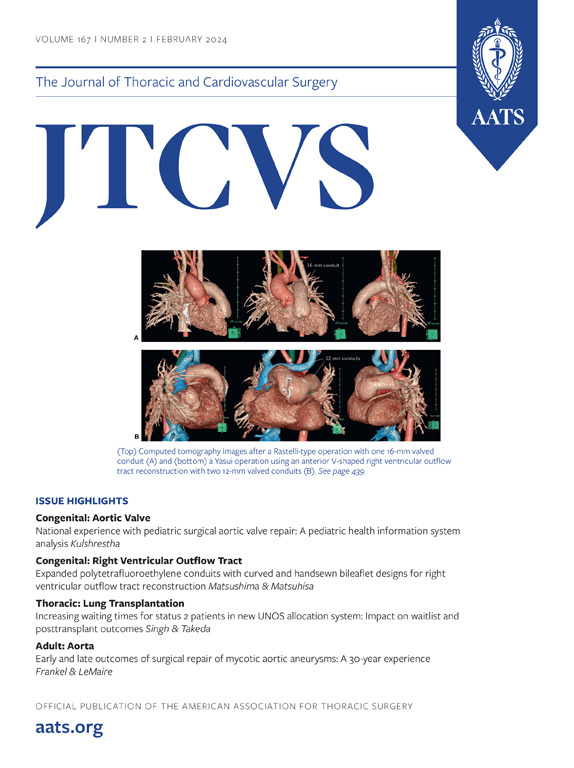残余心房沟通对法洛氏四联症完全修复术患者的影响:倾向得分匹配分析
IF 4.9
1区 医学
Q1 CARDIAC & CARDIOVASCULAR SYSTEMS
Journal of Thoracic and Cardiovascular Surgery
Pub Date : 2024-10-03
DOI:10.1016/j.jtcvs.2024.09.046
引用次数: 0
摘要
目的:外科医生在完全修复法洛氏四联症(TOF)时,可能会因预计右心室生理受限或常规做法而保留残余的心房水平沟通。我们研究了在确定性 TOF 修复时关闭房室间沟通的影响:方法:我们回顾性分析了在手术中接受明确修补术的 TOF 患者:共有 132 名患者(中位年龄:3.5[IQR,1.8-5.8]个月)进行了匹配。最大 VIS(房室间交通通畅:5.0[IQR, 1.8-5.8]个月)无差异:5.0[IQR,4.8-9.0]对无房室间交通:6.0[IQR,5.0-8.0],P=0.78)。此外,肌注治疗持续时间(3.0[IQR,2.0-4.0] vs 3.0[IQR,1.3-4.0]天,P=0.57)、乳酸峰值(2.2[IQR,1.9-3.0] vs 2.3[IQR, 1.9-3.2] mmol/L,P=0.58)、乳酸清除时间(0.2[IQR,0.0-0.3] vs. 0.1[IQR, 0.0-0.3] 天,P=0.57)、胸导管持续时间(4.0[IQR,3.0-6.0] vs. 4.0[IQR, 3.0-5.0] 天,P=0.23)和重症监护住院时间(5.0[IQR, 3.0-7.0] vs. 5.0[IQR, 3.0-7.0] 天,P=0.71)相似。中位随访时间为5.5[IQR,2.7-9.9]年。在有残余血流沟通的患者中,出院时和最近一次随访时的通畅率分别为 93.6% 和 53.7%,其中大多数患者在缺损处有双向分流:结论:在TOF完全修复术中关闭心房水平的沟通对术后近期疗程或中期预后没有明显影响。为了更好地了解通畅度对长期预后的影响,有必要进行进一步研究。本文章由计算机程序翻译,如有差异,请以英文原文为准。

The impact of a residual atrial communication in patients undergoing complete repair for tetralogy of Fallot: A propensity score–matched analysis
Background
Surgeons may leave a residual atrial-level communication during complete repair of tetralogy of Fallot (TOF) in anticipation of restrictive right ventricle physiology or as routine practice. We investigated the impact of closing the interatrial communication at the time of definitive TOF repair.
Methods
We retrospectively reviewed TOF patients who underwent definitive repair at age <12 months between June 2000 and January 2023. Propensity score matching identified 82 patients with a patent interatrial communication and 50 patients with no interatrial communication on postoperative echocardiography (as-treated analysis). The primary endpoint was maximum vasoactive-inotropic score (VIS) as a surrogate for low cardiac output syndrome.
Results
A total of 132 patients (median age, 3.5 months; interquartile range [IQR], 1.8-5.8 months) were matched. There was no difference in maximum VIS (patent interatrial communication: 5.0 [IQR, 4.8-9.0] vs no interatrial communication: 6.0 [IQR, 5.0-8.0]; P = .78). Additionally, the duration of inotrope therapy (3.0 [IQR, 2.0-4.0] days vs 3.0 [IQR, 1.3-4.0] days; P = .57), peak lactate (2.2 [IQR, 1.9-3.0] mmol/L vs 2.3 [IQR, 1.9-3.2] mmol/L; P = .58), time to lactate clearance (0.2 [IQR, 0.0-0.3] days vs 0.1 [IQR, 0.0-0.3] days; P = .57), chest tube duration (4.0 [IQR, 3.0-6.0] days vs 4.0 [IQR, 3.0-5.0] days; P = .23), and length of intensive care unit stay (5.0 [IQR, 3.0-7.0] days vs 5.0 [IQR, 3.0-7.0] days; P = .71) were similar in the 2 groups. The median duration of follow-up was 5.5 years (IQR, 2.7-9.9 years). Among patients with a residual communication, patency rates were 93.6% at discharge and 53.7% at latest follow-up, with most having bidirectional shunting across the defect.
Conclusions
Closure of the atrial-level communication during complete TOF repair does not significantly impact the immediate postoperative course or mid-term outcomes. Further investigation is warranted to better understand how patency influences long-term outcomes.
求助全文
通过发布文献求助,成功后即可免费获取论文全文。
去求助
来源期刊
CiteScore
11.20
自引率
10.00%
发文量
1079
审稿时长
68 days
期刊介绍:
The Journal of Thoracic and Cardiovascular Surgery presents original, peer-reviewed articles on diseases of the heart, great vessels, lungs and thorax with emphasis on surgical interventions. An official publication of The American Association for Thoracic Surgery and The Western Thoracic Surgical Association, the Journal focuses on techniques and developments in acquired cardiac surgery, congenital cardiac repair, thoracic procedures, heart and lung transplantation, mechanical circulatory support and other procedures.

 求助内容:
求助内容: 应助结果提醒方式:
应助结果提醒方式:


